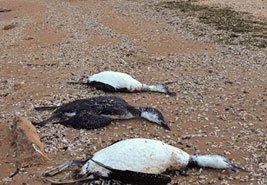About 40 experts met for two days in Windsor, Ontario, to compare research findings about the lake's struggles with algae and work on a report for government policymakers. The gathering was convened by the International Joint Commission, a U.S.-Canadian agency that advises both nations on issues affecting shared waterways.
Blue-green algae is native to Lake Erie, the shallowest of the Great Lakes and the smallest by volume. But the lake has been plagued by increasingly large masses of the substance over the past decade. An outbreak in 2011 spread across huge sections of the central and western basins.
The blooms produce toxins and suck oxygen from the water, creating "dead zones" where little if anything can live. Dogs have died after swimming in the lake and licking themselves, said Jeff Reutter, director of the Ohio Sea Grant College Program, who attended the Windsor session. Water contaminated with blue-green algae has been fatal to people in some places, though not in North America, he said.
Wall Street Journal - online.wsj.com
26 Feb 2013


